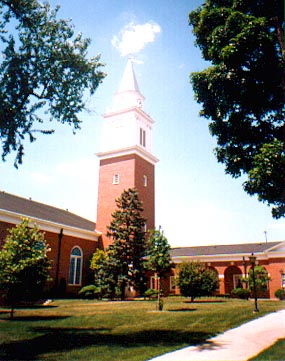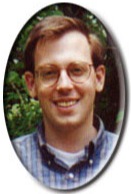 Many of you faithful readers have been notifying us about this Wall Street Journal article published Saturday (for non-WSJ subscribers, this article is thankfully available to all) on the firing of former Wheaton College assistant professor Joshua Hochschild, who was quite popular with students and highly skilled, before and after his conversion to Catholicism.
I apologize for being late on the story, but for me this is old news. The Wheaton College Record, a newspaper operated by students of the college, including my younger sister Sarah Pulliam, wrote about the subject more than a year ago (before I joined GetReligion). No thanks to the Record for not having a website -- I'm told that the school's administration prefers to keep its students' news and views confined to campus -- but the articles I saw were comprehensive and balanced (OK, disclaimer, my sister wrote at least two articles on the subject). This was old news as far as most familiar with the matter were concerned.
Many of you faithful readers have been notifying us about this Wall Street Journal article published Saturday (for non-WSJ subscribers, this article is thankfully available to all) on the firing of former Wheaton College assistant professor Joshua Hochschild, who was quite popular with students and highly skilled, before and after his conversion to Catholicism.
I apologize for being late on the story, but for me this is old news. The Wheaton College Record, a newspaper operated by students of the college, including my younger sister Sarah Pulliam, wrote about the subject more than a year ago (before I joined GetReligion). No thanks to the Record for not having a website -- I'm told that the school's administration prefers to keep its students' news and views confined to campus -- but the articles I saw were comprehensive and balanced (OK, disclaimer, my sister wrote at least two articles on the subject). This was old news as far as most familiar with the matter were concerned.
Who knows what took the WSJ so long to take up the subject, but when it did, it sure did a heck of a job. Rather than focusing on the individual case of a young college professor fired for converting to Catholicism, reporter Daniel Golden took the subject and used it to explore the world of religious higher education from both the Protestant and Catholic perspectives. Golden even delved into the subject of the "weak scholarly tradition" among evangelical Protestants and the issue of whether Catholics believe the Bible is the supreme authority.
It'd be impossible for me to pick out highlights of this piece, so here's Golden's lead:
WHEATON, Ill. -- Wheaton College was delighted to have assistant professor Joshua Hochschild teach students about medieval philosopher Thomas Aquinas, one of Roman Catholicism's foremost thinkers.
But when the popular teacher converted to Catholicism, the prestigious evangelical college reacted differently. It fired him.
Wheaton, like many evangelical colleges, requires full-time faculty members to be Protestants and sign a statement of belief in "biblical doctrine that is consonant with evangelical Christianity." In a letter notifying Mr. Hochschild of the college's decision, Wheaton's president said his "personal desire" to retain "a gifted brother in Christ" was outweighed by his duty to employ "faculty who embody the institution's evangelical Protestant convictions."
The first half or so of the 2,800-word article is spent discussing current and past trends among Christian/Catholic colleges and the dilemma they face as they grow larger and more diverse. Apparently 400 colleges in the United States cite a religious element in their hiring practices, and the 1964 Civil Rights Act allows religious colleges an exemption for hiring practices that would be illegal at most other universities.
 But Golden didn't lead with Hochschild for nothing. He digs into the nitty gritty of Hochschild's firing and conversion. Here is Wheaton President Duane Litfin's explanation in the article for why Catholics must be excluded from the college:
But Golden didn't lead with Hochschild for nothing. He digs into the nitty gritty of Hochschild's firing and conversion. Here is Wheaton President Duane Litfin's explanation in the article for why Catholics must be excluded from the college:
Wheaton has a handful of Catholic students, houses papers of Catholic authors such as J.R.R. Tolkien and welcomes Catholic visiting professors. But it has never hired a Catholic professor full time and tells Catholic applicants it won't consider them for such posts.
In 1993, Wheaton's English department did venture outside Protestant circles, bringing in visiting professor Thomas Howard, whose conversion to Catholicism had cost him a job at an evangelical school in Massachusetts. That same year, Wheaton hired a minister from an evangelical church in Tennessee, Duane Litfin, as its president. One of Mr. Litfin's early acts was to prevent Mr. Howard from giving a speech in the college chapel. Mr. Litfin says his decision was in line with college rules.
Since then, Mr. Litfin has mostly stuck to tradition. An exception in 2003 was easing Wheaton's ban on faculty drinking, which was considered a disadvantage in recruiting.
In a 2004 book titled "Conceiving the Christian College," Mr. Litfin argued that hiring Catholics would start Wheaton down a slippery slope. Wouldn't having Catholic faculty, he asked rhetorically, "lead to a gradual sacrificing of Wheaton's distinctives?"
In an interview, Mr. Litfin acknowledges that a ban on Catholic faculty "narrows the pool that you can draw from." But he says that the school's niche is also a key to its success. "If you look at the caliber of our faculty, this is an amazing place. It's thriving. Why do genetic engineering on it? Why muck up its DNA?"
As president, Mr. Litfin was forced to tackle that question, which came unexpectedly from a young professor traveling a roundabout spiritual journey.
I highly recommend you read what follows on that roundabout spiritual journey. It reflects a trend in America of evangelicals being attracted to the Catholic church's "self-assurance and intellectual history."
 I should say that I was left relatively dumbfounded last year as to why Litfin found it necessary to fire Hochschild and why he even suggested that the rules needed to be updated to reflect that fact. Apparently Hochschild tried to argue that he could subscribe to Wheaton's faith statement -- which is the basis for employment at the college and does not explicitly exclude Catholics. It is Protestant with its emphasis on the Scripture as the "final authority," but Hochschild disagreed that this was the reason for his firing two years before he could have received tenure:
I should say that I was left relatively dumbfounded last year as to why Litfin found it necessary to fire Hochschild and why he even suggested that the rules needed to be updated to reflect that fact. Apparently Hochschild tried to argue that he could subscribe to Wheaton's faith statement -- which is the basis for employment at the college and does not explicitly exclude Catholics. It is Protestant with its emphasis on the Scripture as the "final authority," but Hochschild disagreed that this was the reason for his firing two years before he could have received tenure:
The Bible, he wrote, is indeed the supreme authority for Catholics, who turn to the Church hierarchy only as Protestants consult their ministers. While acknowledging the college's right to exclude Catholics -- and knowing his position was endangered -- he replied that as a matter of principle, "I see no reason why I should be dismissed from the College upon joining the Roman Catholic Church."
Mr. Hochschild was "quibbling," the president retorted four days later. "Perhaps Wheaton College has come to a point where, because of challenges such as yours, it must revise its documents to make more explicit its non-Catholic identity."
Mr. Litfin said the college would terminate Mr. Hochschild's employment at the end of the 2003-2004 school year. He later agreed to let Mr. Hochschild stay another year to find a job. On the eve of Easter 2004, Mr. Hochschild was received into the Catholic church.
My big question is where was the national press on this issue a year ago when it was first raised in the school newspaper? And why only now is the WSJ following on the story? Most media outlets had no problem publishing stories on the college when it finally allowed the students to have a formal dance.
Reconciliation between Protestants and Catholics has always been a big story. Shouldn't a clear attack on that reconciliation at the major evangelical university be a bigger story? Perhaps Protestants and Catholics are not as close as some would like and these types of stories have been kept quiet -- perhaps a reason Wheaton doesn't allow its student newspaper to have a website? Or is this type of story too complicated and intricate for most religion reporters to follow?
The Chicago Sun Times followed in the WSJ's footsteps a few days later with this piece. Oddly, the Sun Times decided to post a number of comments gathered from the conservative Free Republic blog. I can't figure out the logic for this, but whatever. In no way does this story compare with the WSJ piece, but it is interesting to see how the local paper tried to follow in the big national paper's steps after it was scooped in its own backyard.
I should note that a Wheaton source (OK, fine, I have a brother named John Pulliam who also attends the school and majors in economics) tells me that the reporter goofed on the size of its endowment. As of the last quarter, the endowment surpassed $300 million, but the number Golden reported, $294 million, was for the last fiscal year. I guess when you sit on a story for a long time some of your facts will get old.
